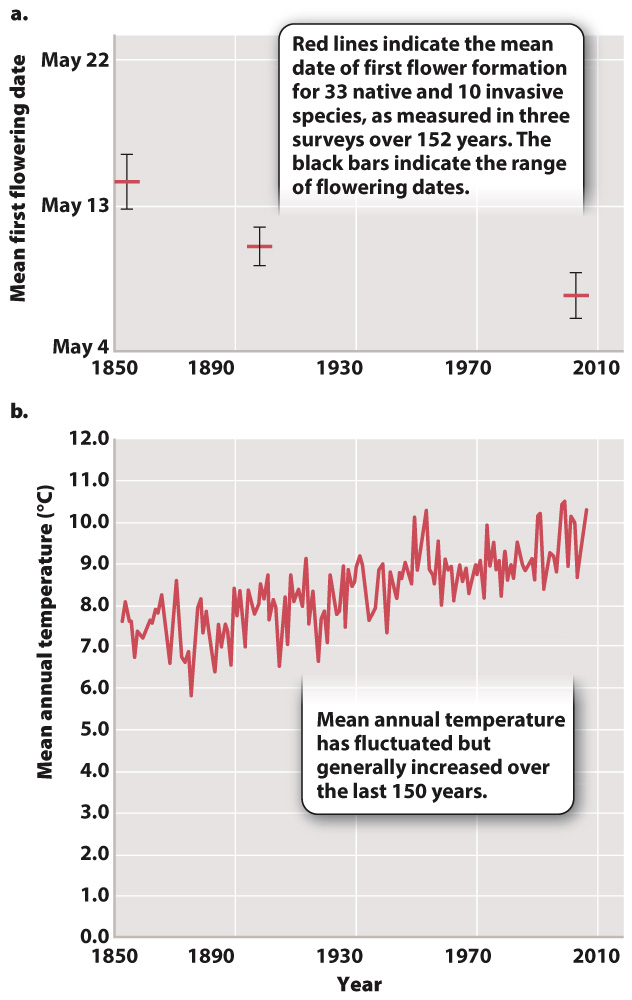Changing environments affect species distribution and community composition.
What will be the consequences of climate change? Without question, some locations will benefit. For example, temperature increase in New England and Scandinavia will mean longer growing seasons. Other regions, however, will suffer. As precipitation patterns change, many places will become drier. Indeed, a number of climate models predict that some of the strongest declines in rainfall will occur in regions that currently produce much of the corn and wheat that feed the world. Already, farmers in southeastern Australia have experienced the worst droughts in a century, and with them unprecedented damage from brushfires. Over much of North America, 2012 was also the driest summer in many decades, and extreme drought returned in the western half of the continent in 2014. Such events are consistent with model predictions, but because of the great natural variability of weather, they do not by themselves confirm climate models. Scientists will be watching carefully to see whether such extreme events increase in frequency in coming years.
To understand how different species will respond to global climate change, we return to basic principles of ecology and evolution. Natural selection describes the changes in allele frequencies that result from the interactions between individuals of a population and their environment. We tend to think about natural selection in terms of individuals’ adapting to a constant or slowly changing environment. In the 21st century, however, the environment will probably be a rapidly moving target, and so genotypes that conferred high fitness in the past may not be the most advantageous in the future.
Plants illustrate the complicated ways in which organisms respond to environmental change. Meticulous notes taken during the 1840s by Henry David Thoreau provide an inventory of plant species diversity in woodlands west of Boston, Massachusetts. Climate records show that mean annual temperature in this area has increased by about 2.5°C since Thoreau began his survey, and in response, many but not all species now flower a week earlier than they did in the nineteenth century (Fig. 49.9). A number of species have declined in abundance or even disappeared since Thoreau’s time, and these tend to be the plants least able to change their flowering time (Chapter 30). Earlier onsets of leaves, flowers, and fruit have been documented in locations distributed widely throughout the temperate zones of North America, Europe, and Asia. The Massachusetts example highlights the simple but important observation that different plant species respond in distinct ways to changing climate, favoring some populations over others.

Quick Check 3 Why should the capacity to shift flowering time influence the distribution of a species during the 21st century?
Quick Check 3 Answer
As ecosystems warm, plants able to open flowers earlier appear to have higher fitness, enabling them to maintain or increase their geographic ranges.
The example of Thoreau’s woods shows that as climate changes, some plants can modify flowering time—
Plants grown in air with CO2 levels like those predicted for the end of this century often change the way that they distribute the products of photosynthesis to different organs: The amount of nitrogen in plant tissues commonly declines, as does the proportion of resources devoted to reproduction. Again, this doesn’t reflect genetic change, just a physiological response to altered environmental conditions. But if environmental change persists for a long time, the varying abilities of different plants to respond physiologically will result in changing allele frequencies, as some variants survive and reproduce better than others. That is, plant populations may evolve by natural selection in response to climate change.
Evolution is one response to global change, but, given the pace at which atmospheric composition and climate are changing, many populations may not have time to adapt. In this case, populations will either migrate or become extinct. Fossils deposited as Earth’s climate warmed at the end of the last ice age show that many plant species dramatically changed their geographic distributions in response to changing climate. As discussed in Chapter 30, trees don’t move, but they can migrate by dispersing seeds to new areas. For example, between 18,000 and 8000 years ago, Red Pine and Jack Pine migrated thousands of kilometers to the north from the Gulf of Mexico, where they lived during the ice age, to their current distributions in the northern United States and Canada (Fig. 49.10a). Hickory also migrated northward, expanding its range rather than simply shifting from one place to another as ice retreated and climate warmed (Fig. 49.10b).

Migration is a potentially important response to environmental changes projected for the 21st century, but it requires a continuous route to get from one place to another, and it is a challenge to find these direct paths on continents broken up by agricultural lands and cities. For this reason, some biologists advocate “assisted migration”: the deliberate transplantation of plant populations from existing habitats to new ones more favorable to growth. To make sure that assisted migration does more good than harm, we need to do more research to understand how plants grow and compete in new ecological situations and under different environmental conditions.